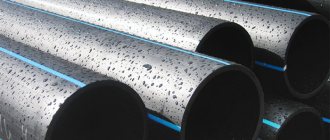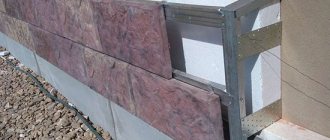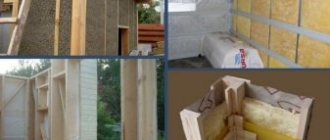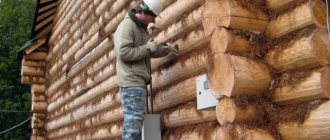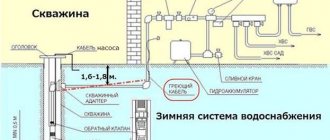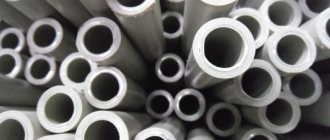A private home provides amenities that the whole family wants to have. Do not depend on the centralized coolant with its wrong temperature. And one cannot tolerate the fact that the water supply occurs with frequent interruptions. But still, autonomous housing - houses, cottages - are also subject to communal extremes. From winter frosts, for example, water in the pipes catches. Therefore, it is necessary to insulate water supply pipes in a private house.
And then the private owner shovels the snow to the side and begins to dig into the place where the water supply is laid. Then he heats the metal pipes with a blowtorch, defrosting the water flow.
He’ll even be glad that he didn’t listen to his neighbors and didn’t install wiring in a plastic pipe. The water in these pipes also froze. A blowtorch will melt the pipes and melt the water, but it will not flow into the house. They are wondering: what will come first - a plastic rupture or a thaw?
Why does the water supply need insulation?
Both owners of private houses realized that the pipes had to be insulated in advance. Moreover, from the water supply network along the street to the houses is only 15 meters. These are meager costs compared to the construction of a separate residential building. Other owners of suburban housing are also thinking about this problem. Study photos of pipe insulation on the website.
And all because they did not fulfill the point of the development project, where even the depth of laying the pipeline in the trench was indicated, which they laid only half a meter deep.
Whereas in this area the level of soil freezing is three times deeper.
Read here: Do-it-yourself insulation: how to properly install external and internal thermal insulation for a private home
Given this natural indicator, it is not at all necessary to dig a ditch of such depth. You can open a bed for water supply in the ground at only 70-80 centimeters. Then the metal or plastic pipe is reliably insulated with modern insulating materials and laid in place.
The water supply to a private house does not immediately enter heated rooms, but also flows through cold ones. Frost can grab the pipes here, and not in the ground. It is more comfortable to do insulation indoors than outside in a snowstorm or 15-20 degree frost. Moreover, where the water meter is installed in the distribution concrete recess. And once again it’s worth thinking about how you can insulate pipes in the ground according to heat.
It is also necessary to insulate the pipeline from your own deep well. Especially if the booster pump is mounted on the head of the upper pipe of an artesian well.
The underwater pipeline into the house in the ditch had to be immediately covered with thermal insulation material. Read below for instructions on how to insulate pipes yourself.
Environmental friendliness, durability, ease of use
Other advantages of polyurethane foam shells include such qualities as environmental friendliness, wear resistance and resistance to microorganisms and many chemicals. This significantly increases the service life of thermal insulation and saves the cost of updating it. Thus, polyurethane foam shell pipe insulation will last 30-50 years while maintaining its performance qualities.
The shells are also easy to install and provide easy access to the damaged section of the pipeline in the event of an accident. In one shift, two workers can insulate up to 300 linear meters of pipeline without special knowledge, which will reduce construction costs and the time it takes to put the facility into operation. If necessary, the shells can be easily dismantled and transferred to another pipeline. At the same time, their thermal insulation and other qualities will be preserved.
People's Council
If the pipeline freezes in winter, and you are not able to insulate it, then open any tap in the kitchen or bathroom more often during the day. Even a thin stream is the movement of the entire pipe flow, and it will not freeze. You also need to open the tap all night, but only if there is a sewer system. Therefore, it is necessary to insulate water and sewer pipes.
On many private estates there is a collapsible pump in the yard, with a “bare” pipe with a tap exiting to the surface. These 80-100 cm pipes to the tap are always filled with water.
It is impossible to make one hundred percent frost insulation. Even if you cover it with a quilted pad or a warm blanket. Incomplete closing of the tap will also help. Let the ice floes grow in the yard, but the pipe will survive the winter.
Methods for insulating water pipes
To prevent frost from damaging water pipes in a private house/dacha/cottage, you need to worry about their thermal insulation in advance.
It is important, even at the stage of laying communications, to consider options for insulating pipes, and not only water pipes. If this is done in a timely manner, the costs will be minimal.
There are quite a lot of options for insulation for pipes - it is important to choose high-quality material among the mass of proposals, without focusing too much on price. The cheapest option is money thrown away
Among the methods of insulating a pipeline for supplying water to a house, the most popular among homeowners are:
- extend the pipeline 0.5 m below the freezing level;
- use a heating cable;
- insulate with heat-insulating material;
- provide an air gap;
- buy a ready-made factory pipe;
- apply several methods at once.
Most often, more than one method is used. So, if the water pipes are deep, then the area responsible for the entrance to the house still needs insulation. Therefore, the most optimal option is selected for it in order to protect the local water supply system.
The depth of the pipeline depends on the region. To find out, you can use special lookup tables by finding your region or check it empirically
The heating cable has become widespread due to its ease of installation and high-quality performance of its functions.
Depending on the type of installation, there are 2 types of cable:
- outer;
- interior.
The first is mounted on top of the water pipe, and the second - inside. It is reliably insulated and made of safe materials. It is connected via a heat-shrinkable sleeve to a regular cable with a plug or to a machine. Read more about heating cable for water supply below.
The heating cable comes in different capacities. Most often found from 10 to 20 W
There are a great variety of thermal insulation materials on the market. They all differ in their properties, quality, price, installation difficulties and service life.
Which one to choose depends on the specific situation.
Among insulation materials, polyethylene and polyurethane foam half-cylinders - shells - are particularly easy to install.
The method of providing an air gap is also often used. It consists of a water pipe placed inside a cheap, smooth plastic or larger diameter corrugated pipe.
Inside there is free space for the circulation of warm air coming from an insulated basement or heated in another way.
Warm air perfectly protects the water pipe from freezing. Although it is often additionally insulated with polypropylene or other material
Another option is to purchase ready-made insulated pipes of factory origin. They are sold completely ready for installation.
They consist of 2 pipes of different diameters placed inside each other. Between them there is a layer of insulation. This insulation method is often called pre-insulation.
The option with ready-made pipes does not always satisfy the needs of a particular user - diameter, type of material and cost can become a real problem for purchasing them
The use of several methods of thermal insulation of pipes is due to the fact that all methods are imperfect and it will not be possible to apply them in all cases. Conditions of use in various households located in all regions of the country are radically different from each other. Therefore, you have to choose the option that suits your specific requirements.
Choice of thermal insulation
The range of materials for reliable winter thermal insulation of pipelines is wide. But a person ignorant of his choice should study not only advertising brochures, but also advice. Including ours.
We will immediately direct potential pipe protectors from frost to select a material based only on the basic characteristics and ease of installation. Let's analyze methods and materials for pipe insulation.
The insulation must have the following properties:
- low level of thermal conductivity;
- minimal absorption of moisture from the soil, since wet thermal insulation loses its properties;
Types of materials for thermal insulation of heating pipes
Technical solutions for pipe insulation differ in design, materials and characteristics.
Mineral wool
Technical insulation made from basalt rock wool for insulation of high-temperature pipelines is produced in wound cylinders, slabs and mats, including those with one-sided foil. It is chemically inert, biostable, non-flammable, has a thermal conductivity of about 0.04 W/m*K and a density of 100-150 kg/m3.
The materials are effective, affordable, but have disadvantages. The use of mineral wool insulation for insulating heating pipes in attics, basements, and technical undergrounds is limited due to high humidity. The tendency to caking and absorption of moisture lead to structural damage, wetting, and rapid deterioration of heat-protective properties.
Polystyrene foam and polystyrene foam
Thermal insulation materials from extruded polystyrene foam and polystyrene foam are made in the form of plates, segments in the shape of half-cylinders. They are used to protect in-house heating pipelines, assemble a closed or U-shaped box when laying a pipeline in the ground.
The insulation has a density of 35-40 kg/m3, a thermal conductivity coefficient of about 0.035-0.04 W/m*K and low water absorption, is not subject to rotting, and is easy to install. The disadvantages include flammability and a narrow range of operating temperatures from -600 to +750C. Pipes must be treated with an anti-corrosion compound before installation in the ground; when laid open, the insulation must be protected from UV rays.
Polyurethane foam
To insulate heating pipes, polyurethane foam shells with and without foil coating are used. The material is characterized by low thermal conductivity 0.022-0.03 W/m*K and water absorption due to the closed cellular structure, high strength, long service life, does not rot, and is quickly installed. Uncoated shells are used only indoors, since polyurethane foam is destroyed under the influence of UV rays.
Insulation of large diameter pipelines can be done using sprayed polyurethane foam insulation. It has increased density and fire resistance, significantly reduces heat loss thanks to a continuous coating without “cold bridges”.
Foamed synthetic rubber
Rubber technical thermal insulation is produced in rolls and tubes. It is non-flammable, environmentally friendly, resistant to chemical and biological influences, has a density of 65 kg/m3 and a thermal conductivity of 0.04-0.047 W/m*K.
The materials are used for insulation of pipelines in premises laid above-ground and underground; they can have an aluminized coating to protect against mechanical damage and UV rays. The main disadvantage is the high cost.
Foamed polyethylene
Thermal insulation for heating pipes made of foamed polyethylene with an elastic porous structure is used in any conditions, does not absorb water, and maintains a low thermal conductivity of 0.032 W/m*k when temperature changes. It is available in tube, roll, and mat formats and is easy and quick to install.
The material is used indoors, heating points, when laying pipes outdoors, in the ground. For above-ground installation it is necessary to provide a covering layer, for underground installation - a casing.
Where is thermal insulation needed?
It would seem that the answer is obvious even to people far from heating engineering: in order to prevent heat loss and cooling of the water, it is necessary to insulate the pipes running along the street. That's right, this is the most understandable situation, but there are many other nuances when laying highways within a building.
Often, even thermal insulation of heating pipes in an apartment is required. So, it is necessary to insulate house networks with coolant under the following conditions:
- passage of the supply or return pipeline through cold or poorly heated rooms - attics, basements, built-in garages, and so on;
- when embedding lines and connections to radiators into a wall or floor screed;
- laying pipes behind various screens, inside plasterboard partitions and other similar methods of hidden installation;
- connections from the heating circuits of underfloor heating at the point of their connection to the distribution manifold.
Note. It is also practiced to cover pipelines passing through rooms with excessive heat release from various equipment and household appliances. For example, pipes with thermal insulation will be useful in a boiler room, where emissions from various units inevitably occur and the temperature is unreasonably high.
If the conditions described in the first paragraph are quite clear, then the rest need clarification. The fact is that heating of the rooms is provided by radiators, and the task of the mains and connections is to deliver heat to them. If they are embedded in walls or floors, then thermal insulation is needed for the pipes, otherwise in this case part of the heat will go to heating the building structures, which is not at all necessary. This is especially important when the wall borders the environment.
For reference. The insulation layer also plays the role of a damper when embedding polypropylene pipes, famous for their ability to significantly elongate when heated.
Mains located inside plasterboard partitions and behind screens will increase the temperature in a confined space, which is not practical. To avoid wastage of thermal energy and deliver it to the batteries without loss, thermal insulation for heating pipes is necessary. At the same time, pipelines laid openly in heated rooms do not need insulation, since they still heat the space of these rooms.
As for water heated floors, a situation often arises when many connections from heating circuits converge to the distribution manifold from all rooms. As a result, the distance between them decreases, the concentration of pipes in a small area increases, and the area of the floor in front of the collector begins to overheat. That is why the supply pipes should be insulated in this place.
How to properly install thermal insulation?
You need to think about the thermal insulation of a local water supply system at the stage of its construction. This is the right time to calculate, buy and arrange everything. Moreover, if a team is working on the site, then it will take care of all implementation issues. It is important for the owner to express his wishes regarding the type of material, its price and be sure to check that everything is done according to the wishes.
It is important to control the work of hired craftsmen so that they do not use cheap material, passing it off as an expensive analogue
If you have to do the insulation yourself, then, compared to planning and calculating the water supply system, this will turn out to be a simple task.
Depending on how and where the pipeline runs and which areas are to be insulated, the actual steps for laying the insulation will depend. The most common option is when the pipes go below the freezing depth or slightly above. In the first case, there is no need to insulate them, but in the second, the most convenient option is selected. The length of the pipeline also plays an important role here.
Most often, a heating cable is laid on a water pipe. This is especially true in areas leading into the house. When installing the cable, use the recommendations of the manufacturer of this product, placing the turns at the required distance.
The heating cable allows you to regulate the temperature on the pipe surface thanks to a sensor. It can be turned on and off at your discretion
Then a layer of insulation is placed on top of the attached cable, securing it properly. These can be polyurethane foam shells or Penoplex segments. Having fastened the insulation parts together, you need to carefully glue the joints with special tape.
There is also an article on our website about how to properly insulate underground water pipes. We recommend reading it too.
Pipeline sections located in the basement are also insulated. To do this, take liquid polyurethane foam. And applied to the surface of the pipes. This should be done carefully, using personal protective equipment - you need to protect your hands, eyes, and avoid contact with mucous membranes and respiratory organs.
Polyurethane foam 1.5 cm thick perfectly performs the functions of 5 cm of insulation, and paint - a couple of mm
After drying, all that remains is to apply protective paint to the surface of the polyurethane foam coating. This will protect against the influence of environmental factors and extend the service life of the insulation.
